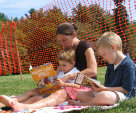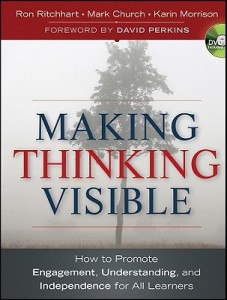Making Thinking Visible: Promoting Engagement, Understanding & Independence
Making Thinking Visible: How to Promote Engagement, Understanding and Independence for All Learners
By Ron Ritchhart, Mark Church and Karin Morrison
(Jossey-Bass/Wiley, 2011 – Learn more)

I heard about Project Zero and visible thinking a few years ago and it’s been on my list of things to learn more about when I had time, so I was excited to find Making Thinking Visible in my mailbox over the summer.
What I didn’t expect was that reading the book would be like the fireworks show I saw for the 4th of July. There was a sense of excitement that repeated on each page and section as I thought of the myriad ways I could share this with teachers in my building.

More about the book
This book centers around the premise that “it is important to nurture thinking in the daily lives of learners and to make it visible so that a culture of thinking can be built and a strong learning community established” (xxi). I suspect that none of us would dispute that claim, but few of us would know precisely how to make that a reality. Ritchhart encourages readers early on, saying, “Have confidence in every learner’s ability to think and your capacity to nurture that thinking” (xx).
The tone and style of this book are clear and conversational. While it is rich with content, readers don’t need to work hard to access it. The authors write in the voice of teachers and so it is like sitting with a mentor who is familiar with the context of our own work.
The book is infused with “picture(s) of practice” in which we glimpse real teachers from schools across the globe experimenting with the thinking routines. Not all of them were instantly successful, so these glimpses into other teachers’ journeys of discovery make it safe to acknowledge our own past or present assumptions or limitations.
Some Thinking about Thinking
Part one of the book centers around a conversation about what thinking is. Forms of the word “thinking” are ubiquitous in our language, but it is difficult to put our fingers on just what it means. The authors reference Bloom and move beyond that initial taxonomy, beyond the work that students do, to the thinking that moves behind the actions. “When you tell someone you are thinking, what kind of things might actually be going on in your head?” (16).
But how do you help a child get better at something you can’t see him doing? The answer that these authors put forward is to make students’ thinking visible: “To make sure thinking isn’t left to chance and to provide us with the information we need in order to respond to students’ learning needs, we must make their thinking visible” (27).
Beyond allowing us to witness their thinking, these practices give students active ownership in their learning. This approach complements Common Core expectations, as well as Concept Based Curriculum models adopted by many districts, or Project Based Learning. Cue the symphony because these are valuable tools for everyone in education today.
Move Over KWL: The Thinking Routines
Move over KWL (with your static approach to facts and knowledge)! Each of these thinking routines has been refined to promote the process of active learning through thinking. These move students toward greater autonomy and provide a scaffold upon which routines learned for use with a group can be transferred to independent practice.
Part two of the book first orients readers to the organization of the routines. While several other possibilities are acknowledged, the authors chose to sort the routines into three groups: routines for introducing and exploring ideas, routines for synthesizing and organizing ideas, and routines for digging deeper into ideas. That being said, the routines may work in more than one category.
I have been visualizing all the different ways I can use these routines with teachers as well as students. Even though I am a K-5 reading consultant, I can imagine, and the authors describe, many ways to use these routines in all content areas and settings including secondary or pre-k classrooms, and even with professional groups or in museums. As I read this, the colors were swirling and the fireworks popping with each new possibility!
And so a word of caution from the authors: be careful not to use these like the flavor of the day. These thinking routines can be most powerful when they become embedded into our practices in seamless, purposeful and practiced ways. When students (and teachers) can stop thinking about how to use the routine and start using it as leverage for their thinking, it propels thinking forward.
Another word of caution: many of these routines lead to rich discussion; be careful not to reduce them to worksheets.
Each routine comes with a user-friendly guide that includes:
- a bulleted overview,
- the purpose,
- notes about selecting appropriate content,
- steps for using the routine,
- uses and variations for the routine,
- assessment of students’ thinking,
- tips for optimizing your outcomes,
- a picture of practice.
After a week, my copy of the book was dog-eared and flagged, with double underlines and stars in the margins. I couldn’t wait to start using these.
Bringing the Power of Visible Thinking to Life
Each of these routines could be valuable, but part three explains how incorporating select routines can create “a place where thinking is valued, visible, and actively promoted.”
What are you waiting for? Find a copy of Making Thinking Visible and enjoy your own private fireworks display.
Katie Gordon just completed her first year as an elementary reading consultant and coach, splitting time between building the reading capacity of her students and the teaching capacity of her colleagues. She comes to coaching from 10 years in middle and high school classrooms, during which time she struggled to find the answers for the challenges her own students were facing. Their struggles lead her to read copiously and eventually enroll in a sixth year program in reading.


































